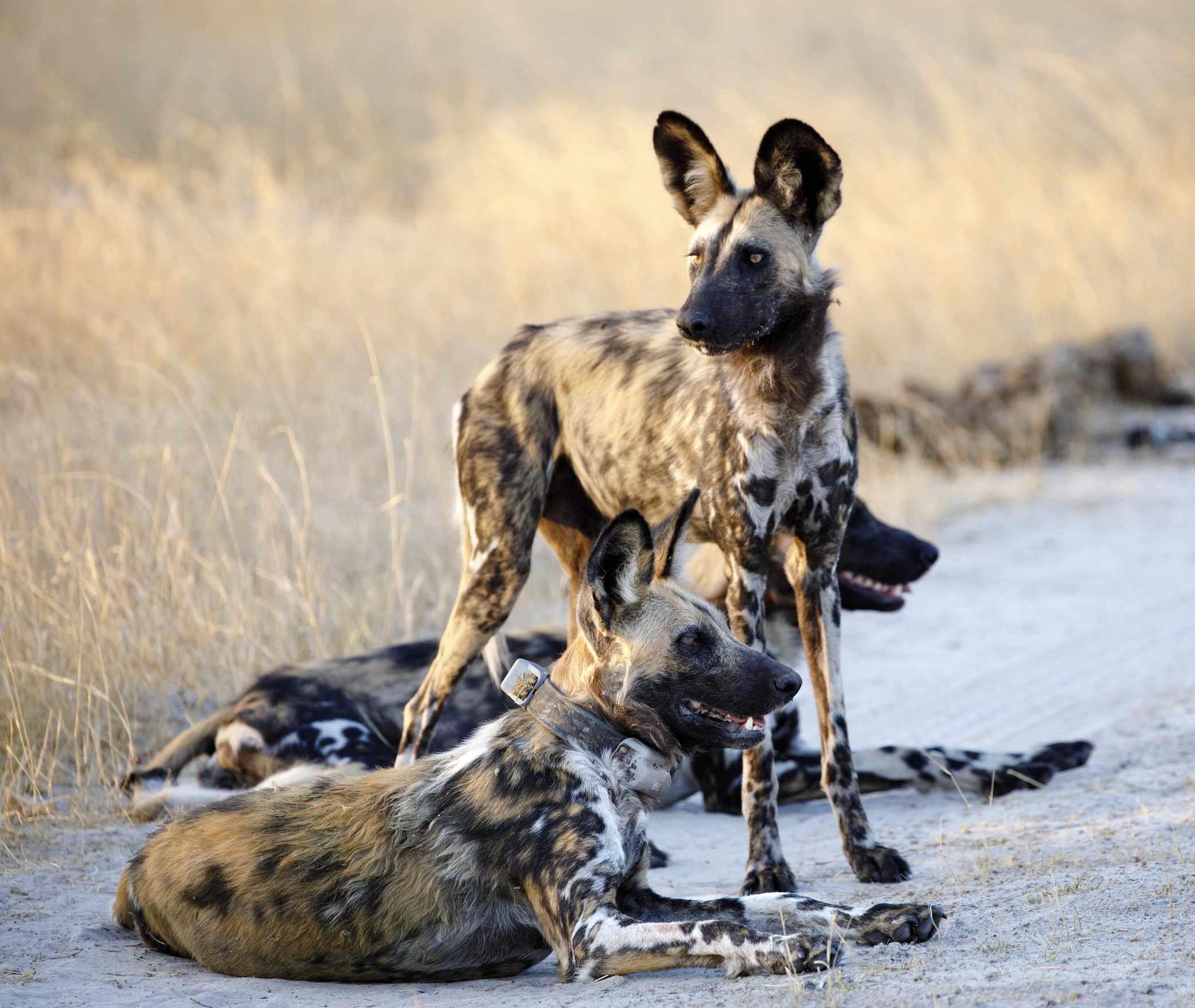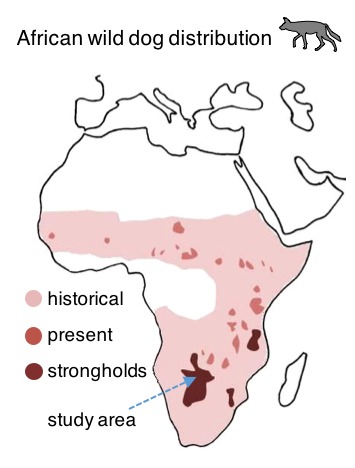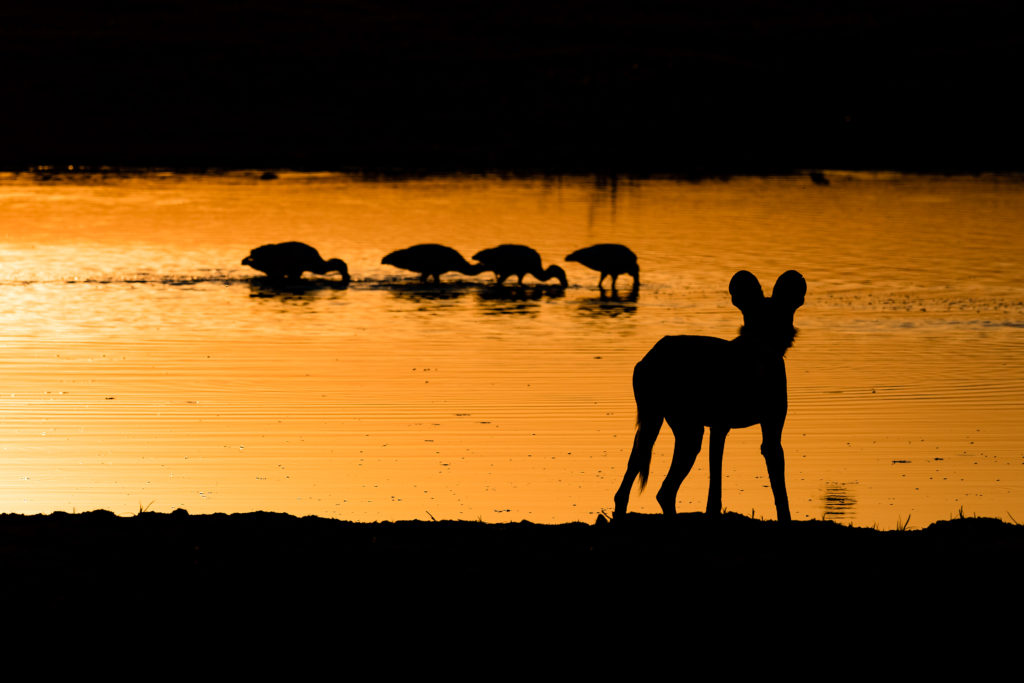
In collaboration with the Botswana Predator Conservation Program, we study the population dynamics of African wild dogs in the Okavango Delta.
The African wild dog (Lycaon pictus) is Africa’s most endangered large carnivore and is listed as endangered in the IUCN Red List. The species was formerly distributed throughout sub-Sahara Africa but today it has disappeared from most of its former range. Less than 6’000 free-ranging individuals survive in the wild, and the species has been given very high conservation priority. One major threat to the survival of the species is the loss and fragmentation of suitable habitats due to expanding human population. As a result, wild dogs are forced to live in isolated small subpopulations, which are particularly vulnerable to extinction.
Dispersal of individuals is a fundamental process governing the dynamics of socially and spatially structured populations. Through emigration and immigration, dispersing individuals lead to the formation of new groups, can rescue small subpopulations, and recolonize unoccupied areas. There is, however, a mismatch between our understanding of the complexity of dispersal and our representation of dispersal in population dynamic models. This is particularly the case for species characterized by long-distance dispersal, such as the African wild dog, as the fate of dispersers is often unknown and consequently neglected.

The Okavango Delta in Botswana represents one of the last strongholds for this endangered carnivore in southern Africa and, through dispersing individuals, the resident population likely acts as a source population for the natural re-colonization of the surrounding regions. Under these circumstances, understanding how and where wild dogs disperse, and assessing connectivity between subpopulations is fundamental for the management and conservation of the species across large wildlife landscapes such as the Kavango Zambezi Transfrontier Conservation Area (KAZA/TFCA), for which wild dogs have been identified as a flagship species. Recent miniaturization of tracking devices finally allows us to follow dispersers in their whereabouts and collect information on dispersal movement patterns (e.g. travelled distance) and dispersal success (e.g. survival rate during dispersal), and to evaluate connectivity across the landscapes of KAZA/TFCA.
The aim of this project is to improve the long-term viability and connectivity of African wild dog subpopulations nationally and across the KAZA/TFCA landscapes by providing new empirical evidence and novel information on dispersal and its demographic consequences. To this end, we bring together novel information on dispersing individuals and 25 years of individual-based life-history data from resident groups to provide an explicit investigation of dispersal in African wild dogs. We deploy GPS/Satellite radio collars on sub-adult African wild dogs that disperse from their natal group, to collect information on dispersal patterns, habitat use and selection during dispersal, survival, settlement success in a new territory, and reproductive success of newly formed packs. This information on dispersing individuals will be merged with existing long-term demographic data on resident groups to inform a spatially explicit demographic model at an unprecedented level of detail. Our project will allow assessing population viability and extinction risks under changing environmental and anthropogenic scenarios and thus help identifying key conservation actions. Results from this project will be used to inform effective national and international management plans.
This project complies with one of the main objectives identified in the Regional conservation strategy for the cheetah and wild dog in southern Africa (IUCN/SSC 2009) in the “Strategic plan for African wild dogs in KAZA 2014 – 2018” (KAZA TFCA Secretariat, 2014) that aim to improve awareness and knowledge by “acquiring a better understanding of dispersal, habitat use and connectivity for wild dogs”.
African wild dogs

By placing dispersal into a wider ecological and demographic context, this project will increase our fundamental biological understanding of dispersal and help improve our ability to predict and manage the responses of endangered carnivores to environmental and anthropogenic perturbations. This project will provide an important scientific insight for evidence-based conservation of the African wild dog, but also for other wide-ranging carnivores such as the cheetah and the lion.
For any further enquires please contact wilddogdispersal@gmail.com
Sponsors
Financial support has been granted by University of Zurich, National Geographic Society, Idea Wild, Jacot Foundation, Parrotia Foundation, Temperatio Foundation, Basler Foundation for Biological Research, Albert-Heim Stiftung, Wilderness Wildlife Trust, and Swiss National Science Foundation.
In collaboration with:
Botswana Predator Conservation
Citizen science – How you can help!
Research updates and documents
- Yearly Research Update 2017
- Yearly Research Update 2018
- Yearly Research Update 2019
- Yearly Research Update 2020
- Yearly Research Update 2021
- Yearly Research Update 2022
Published articles
- African wild dog dispersal and implications for management
- When to stay and when to leave? Proximate causes of dispersal in an endangered social carnivore
- Bound within boundaries: Do protected areas cover movement corridors of their most mobile, protected species?
- A three-step approach for assessing landscape connectivity via simulated dispersal: African wild dog case study
- Higher mortality is not a universal cost of dispersal: A case study in African wild dogs
- An AI-based platform to investigate African large carnivore dispersal and demography across broad landscapes: A case study and future directions using African wild dogs
Project teaser
Below is a 3-minutes long video clip explaining our wild dog dispersal project in Swiss German (the English version will follow). For now, if you do not understand Swiss German, just lay back and enjoy some beautiful footage of this charismatic species.
